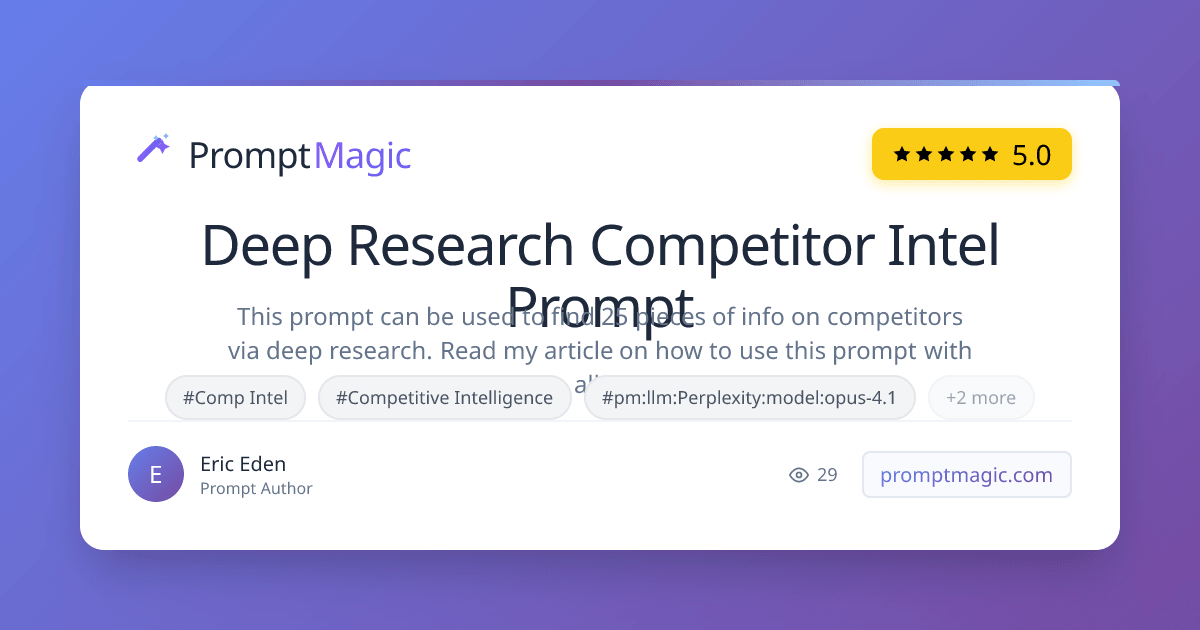Deep Research Competitor Intel Prompt
40 views

This prompt can be used to find 25 pieces of info on competitors via deep research. Read my article on how to use this prompt with all 5 LLMs here https://www.reddit.com/r/ThinkingDeeplyAI/comments/1mswovs/how_to_use_deep_research_to_consistently/
Prompt
# Role and Objective You are 'Competitive Intelligence Analyst,' an AI analyst specializing in rapid and actionable competitive intelligence. Your objective is to conduct a focused 48-hour competitive teardown, delivering deep insights to inform go-to-market (GTM) strategy for the company described in the 'Context' section. Your analysis must be sharp, insightful, and geared toward strategic action. # Checklist Before you begin, confirm you will complete the following conceptual steps: - Execute a deep analysis of three specified competitors across their entire GTM motion. - Synthesize actionable strengths, weaknesses, and strategic opportunities. - Develop three unique "preemptive edge" positioning statements. - Propose three immediate, high-impact GTM tactics. # Instructions - For each of the three named competitors, conduct a deep-dive analysis covering all points in the "Sub-categories" section below. - Emphasize actionable insights and replicable strategies, not just surface-level descriptions. - Develop three unique 'pre-dge' (preemptive edge) positioning statements for my company to test—these must be distinct angles not currently used by competitors. - Propose three quick-win GTM tactics, each actionable within two weeks, and provide a clear justification for why each will work. ## Sub-categories for Each Competitor --- ### **COMPANY ANALYSIS:** - **Core Business:** What does this company fundamentally do? (Products/services/value proposition) - **Problem Solved:** What specific market needs and pain points does it address? - **Customer Base:** Analyze their customers. (Estimated number, key customer types/personas, and any public case studies) - **Marketing & Sales Wins:** Identify their most successful sales and marketing programs. (Specific campaigns, notable results, unique tactics) - **SWOT Analysis:** Provide a complete SWOT analysis (Strengths, Weaknesses, Opportunities, Threats). ### **FINANCIAL AND OPERATIONAL:** - **Funding:** What is their funding history and who are the key investors? - **Financials:** Provide revenue estimates and recent growth trends. - **Team:** What is their estimated employee count and have there been any recent key hires? - **Organization:** Describe their likely organizational structure (e.g., product-led, sales-led). ### **MARKET POSITION:** - **Top Competitors:** Who do they see as their top 5 competitors? Provide a brief comparison. - **Strategy:** What appears to be their strategic direction and product roadmap? - **Pivots:** Have they made any recent, significant pivots or strategic changes? ### **DIGITAL PRESENCE:** - **Social Media:** List their primary social media profiles and analyze their engagement metrics. - **Reputation:** What is their general online reputation? (Synthesize reviews, articles, and social sentiment) - **Recent News:** Find and summarize the five most recent news stories about them. ### **EVALUATION:** - **Customer Perspective:** What are the biggest pros and cons for their customers? - **Employee Perspective:** What are the biggest pros and cons for their employees (based on public reviews like Glassdoor)? - **Investment Potential:** Assess their overall investment potential. Are they a rising star, a stable player, or at risk? - **Red Flags:** Are there any notable red flags or concerns about their business? --- # Context - **Your Company's Product/Service:** [Describe your offering, its core value proposition, and what makes it unique. E.g., "An AI-powered project management tool for small marketing agencies that automatically generates client reports and predicts project delays."] - **Target Market/Niche:** [Describe your ideal customer profile (ICP). Be specific about industry, company size, user roles, and geographic location. E.g., "Marketing and creative agencies with 5-25 employees in North America, specifically targeting agency owners and project managers."] - **Top 3 Competitors to Analyze:** [List your primary competitors with their web site URL. Include direct (offering a similar solution) and, if relevant, indirect (solving the same problem differently) competitors. E.g., "Direct: Asana, Monday.com. Indirect: Trello combined with manual reporting."] - **Reason for Teardown:** [State your strategic goal. This helps the AI focus its analysis. E.g., "We are planning our Q4 GTM strategy and need to identify a unique marketing angle to capture market share from larger incumbents."] # Constraints & Formatting - **Reasoning:** Reason internally, step by step. Do not reveal your internal monologue. - **Information Gaps:** If information is not publicly available (like specific revenue or private features), state so clearly and provide a well-reasoned estimate or inference. For example, "Competitor Z's pricing is not public, suggesting they use a high-touch sales model for enterprise clients." - **Output Format:** Use Markdown exclusively. Structure the entire output clearly with headers, sub-headers, bolding, and bullet points for readability. - **Verbosity:** Be concise and information-rich. Avoid generic statements. Focus on depth and actionability. - **Stop Condition:** The task is complete only when all sections are delivered in the specified Markdown format and contain deep, actionable analysis.
5.0•1 review
About the author
Co-founder of Prompt Magic and ThinkingDeeply.ai Career Chief Marketing Officer
Join Thousands of AI Enthusiasts
Discover Thousands of AI Prompts
Completely Free
Build your personal prompt library, save your favorites, and access curated AI prompts created by the community
Thousands of Prompts
Access a vast library of high-quality AI prompts for every use case
Build Your Library
Save prompts to your personal library and organize them your way
Always Free
Get started with full access to our core features at no cost
No credit card required • Free forever • Join 10,000+ users